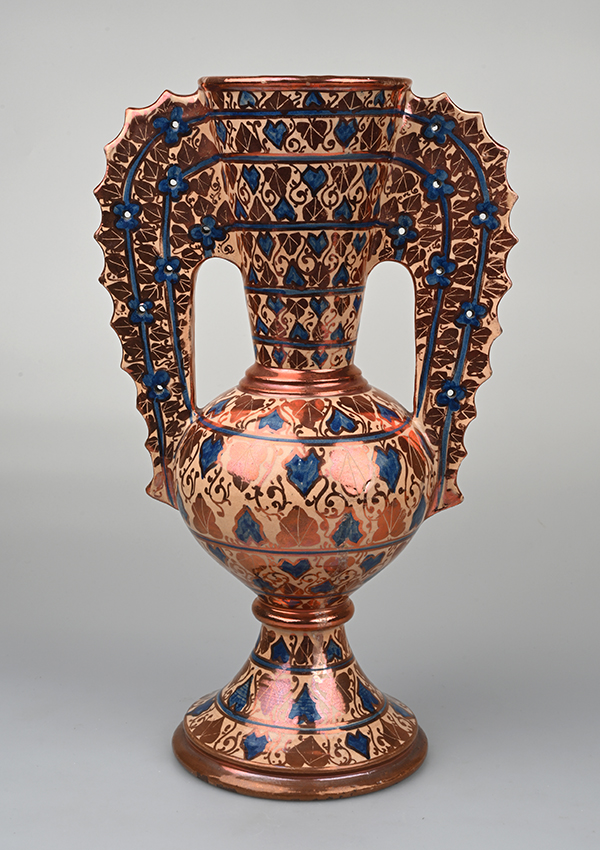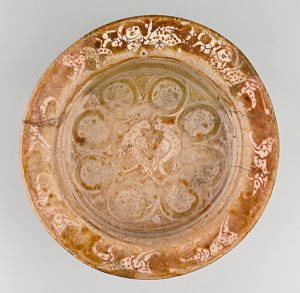
Vase (winged vase), Spain, Province of Valencia, Manises, c. 1880-1900. Faience, thin glaze with copper lustre and blue brushwork decoration.
Andreas Heege und Pierre-Yves Tribolet, 2023
The terms lustre, lustreware, or luster (from Lat. lustrare – to polish, to shine) refer to a metallic sheen or iridescent glaze on pottery, mainly faience, refined white earthenware and porcelain.
The lustre glazes on early Islamic/Spanish or Italian maiolica from the 9th to 16th centuries were emulsions of metal sulphates or oxides mixed with vinegar and ochre applied to the surface of pieces that had already been fired and glazed. They were then fired a second time in a reducing atmosphere (muffle firing) at a moderate temperature to fuse the lustre. In modern artisanal pottery making, all-over and runny lustre glazes are achieved by adding metal nitrate and metal chloride solutions before the second firing.


Bowl (tripod bowl), Iran (Persia), c. 1200-1220, faience (Kashan style, lustreware), glazed both inside and out, base unglazed, red-brown lustre painting and Arabic writing.
Lustreware was first made in the 9th and 10th centuries in Mesopotamia and Persia. The first Hispano-Moresque production of lustreware is attested to in 13th-century Málaga and Granada. A major centre of gold lustreware production later existed at Manises near Valencia. Between c. 1500 and 1570, the pottery was exported via Mallorca to Italy, where it was copied by the potters of Derita and became known as Maiolica (golden yellow lustre glazes combined with other high-temperature colours). Lustreware from Gubbio, another centre of production (until c. 1630), on the other hand, was coppery red in colour
From the late 18th century, lustreware experienced a period of revival in England and on the Continent, albeit using a newly developed technique. Another important lustreware manufacturer in the 1900s was Clément Massier (1844-1917) in Golfe-Juan and Vallauris in the South of France. Around the same time, Vilmos Zsolnay (1828-1900) was producing lustreware in Pécs, Hungary.
Translation Sandy Haemmerle
French: lustre
German: Lüster
References:
Wikipedia page on Lustreware
Blondel 2001
Nicole Blondel, Céramique, vocabulaire technique, Paris 2014, 268-273.
Caiger-Smith 1985
Caiger-Smith, A., Lustre Pottery: Technique, Tradition and Innovation in Islam and the Western World, London 1985.
Caroscio 2004 (2007)
Marta Caroscio, Lustreware production in Renaissance Italy and influences from the mediterranean area, in: Medieval ceramics 28, 2004 (2007), 99-115.
John/Baker 1951
John, W.D., and Warren Baker, Old English Lustre Pottery, Newport), n.d. (ca 1951).
Litzow 1984
Karl Litzow, Keramische Technik. Vom Irdengut zum Porzellan, München 1984.
Watson 2004
Oliver Watson, Ceramics from islamic lands, London 2004.
Weiß 1991
Gustav Weiß, Keramik-Lexikon. Praktisches Wissen griffbereit, Berlin 1991, bes. 193.

